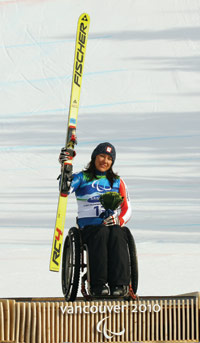
Alana Nichols is a paragon of adaptive sport. When she rolled onto the medal podium for the fourth time at the Alpine sit-ski course at the 2010 Paralympics, she sat not only as Team USA’s top medalist, but as a beau ideal of the Paralympic dream. The Games were launched in 1966 to give people with physical disabilities the opportunity to compete with each other on an equal playing field, in conjunction with the Olympics. Since then, thousands of people have worked to make the Paralympic Games a magnet for those willing to drive themselves to world-class accomplishment and self-transformation through sport. In this interview, Nichols told The O&P EDGE about becoming a two-season Paralympian, her race to the top, and the work ethic that got her there.
The O&P EDGE: Alana, how did you start monoskiing, and how long did it take you to realize it was something you wanted to really throw yourself into?
Nichols: I actually broke my back snowboarding in 2000. About two years after my accident, I was offered a scholarship to a small adaptive skiing program in the Santa Fe ski basin. I honestly don’t know how they got my name, and since it was just a year after my accident, I was still mourning my loss and recovering, and I turned them down. But they offered it again the following winter, and I went out two or three times. In 2006 during the Torino Games, I wasn’t even skiing independently yet, but I vividly remember watching the Games on my laptop in my dorm room and thinking, “I really want to do this.” It wasn’t until last year when I started training and competing with the National Sports Center for the Disabled at Winter Park, Colorado, that I first realized that the Paralympics were kind of within my reach.
The O&P EDGE: Because you were exposed to Paralympic sport, you’ve traveled all over the world and done things that most people could only dream about—becoming part of the second-largest sporting event in the world, twice so far, with no end in sight, and you’ve spent a huge amount of time training. How has this changed you?
Nichols: When I first learned about Paralympic sport and adaptive athletics, it was really a light in my life. When I broke my back I had big identity issues because being an athlete was what I was. Then, when I first heard about wheelchair basketball, I started to have hope…. I also think [adaptive sport] extends farther than just people with disabilities—there are so many people with differences out in the world that need to know that their difference is a good thing and doesn’t have to hold them back—it can actually be something that helps them excel in life. I don’t know if I would have a master’s degree now or three gold medals if I didn’t have this disability and I hadn’t walked through some of those doors that were opened for me after I broke my back. And now, I get to be someone other young women and even young men with disabilities look up to, and I take a lot of pride in just living it.
The O&P EDGE: “Just living it”—what does that mean to you?
Nichols: I think the only way that Paralympic sport is going to be taken seriously is if people actually see athletes like [me] doing the work that it takes to be at the highest level. One thing that Lindsay Vonn really prides herself on is that she’s in the gym five days a week, preparing herself to be the best in the world. If I want to claim to be the best in the world and live that goal of mine, I have to do that level of work. I want [to] prove to people that if you’re willing to do the work, then you can see the results. I want to live my life as an example of an athlete first and disabled second. That’s what I mean by living it. [Laughing] It’s ‘walking the walk,’ if you will.




